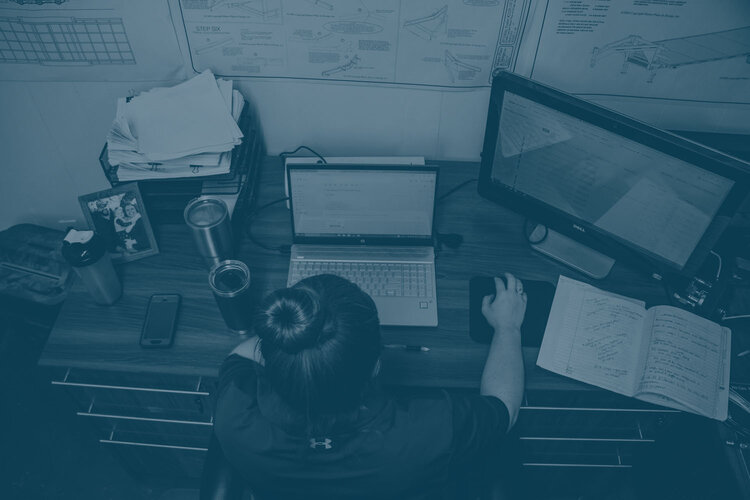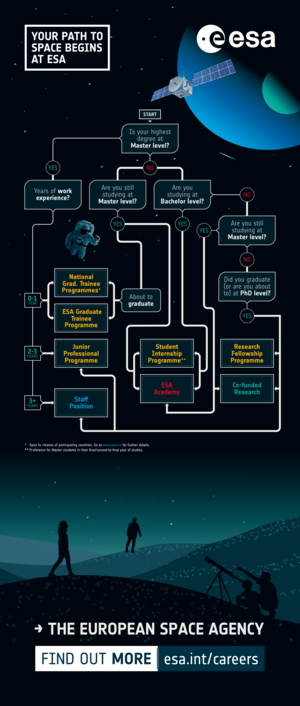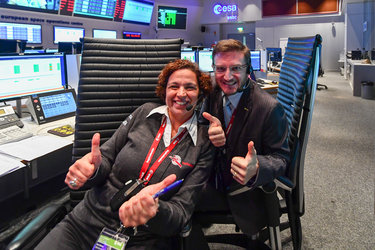I'm an ESA Graduate Trainee and I work with software and AI
Each year in February, the European Space Agency opens its call for applications for its ESA Graduate Trainee Programme. Opportunities are now available in engineering, science, IT and business services. The programme offers recently graduated Master’s students a unique opportunity to work on inspiring space missions at the heart of European space activities. ESA Graduate Trainees will join our team of scientists, engineers and business professionals from all over Europe working together in an international and friendly environment. Here we learn more about the programme with EGT Nicole Rosi, who is currently working with software and AI.
Can you introduce yourself and tell us about your academic and professional background?

Hi, I’m Nicole. I have a BSc in Physics and Astrophysics and an MSc in Nuclear and Subnuclear Physics. I have always been passionate about coding and artificial intelligence (AI) and have worked on projects related to this topic since my Bachelor’s thesis.
My career path began with an internship at CERN, where I studied the rate capability of micro-pattern gaseous detectors in extreme radiation environments for the Compact Muon Solenoid (CMS) experiment. Later, I moved to Denmark, where my journey in AI truly started. At the Technical University of Denmark, I developed physics-informed machine learning models to accelerate wind turbine wake simulations.
Thanks to my experience in physics and AI, I had the opportunity to join ESA’s Graduate Trainee Programme - an achievement I still consider the highlight of my career so far! After spending my first year with ESA’s Advanced Concepts Team (ACT), I joined the newly-formed Software and Artificial Intelligence section for the second year.
This transition allowed me to gain experience with two ESA directorates: first with Technology, Engineering and Quality, and now with Human and Robotic Exploration. It has also given me the experience of working at two ESA sites: ESTEC, located in the Netherlands and the largest ESA facility, and EAC in Cologne, where ESA’s astronaut-related activities take place.
Why were you interested in the ESA Graduate Trainee Programme?
I have always felt a deep connection to fundamental questions like, “Where do we come from?” and “How was our universe created?” These questions initially led me to choose physics as my field of study. However, as I progressed through my studies, I realised that I am also strongly inclined toward engineering disciplines. I enjoy tasks like connecting cables, taking measurements, coding and exploring how to achieve high levels of autonomy in environments that are particularly harsh - not just for humans but also for technology.
Given this combination of interests, I saw ESA as the perfect place to contribute my skills. At ESA, I can work closely with scientists, supporting their missions by helping them to achieve their objectives and improve the technology and strategies that enable European space exploration.
What is your role at ESA? Could you describe a technical project or research activity you have been involved in?
Currently, I work in the Software and Artificial Intelligence section. My role involves identifying the most promising quantum computing and AI technologies for the future of space exploration. Together with an ESA intern, I am developing a small project on Moon navigation that leverages quantum annealing and reinforcement learning to schedule and actuate rover navigation on the Moon's surface. The project aims to ensure a high level of autonomy during missions – and my enthusiasm for it more than compensates for the challenges of starting a new project in such a technical and multidisciplinary area.
Which areas of ESA’s work excite you the most, and how do you see yourself contributing to them as part of this programme?
For me, it’s the transformation process that turns technologies into real missions. I perceive this as one of the most challenging aspects of space exploration because engineers are often required to define solutions or technology development trends years before a mission is launched. This demands careful consideration of how the technological landscape evolves over time. This challenge is particularly evident in areas like hardware/software (HW/SW) integration with the advancement of quantum computing, and even more AI.
Studying physics has equipped me with a highly logical thinking scheme and the competencies to engage with mathematics, physical processes and HW/SW technologies. I aspire to further develop these skills and contribute by bridging the gap between the vast array of emerging technologies and what makes sense in real mission scenarios - considering constraints like weight, power consumption, radiation and other critical factors.
In the future, it would be an immense privilege to direct this transformation process and see it realised in ESA missions!
What are your career goals, and how do you believe the ESA Graduate Trainee Programme aligns with those aspirations?
My career goal is to serve science from an engineering and hands-on perspective. My main aspiration would be to become the manager of a laboratory that prototypes HW/SW solutions for spacecraft and rovers. The EGT Programme is the perfect place to start, as it brings you to the core of space exploration and offers an almost 360-degree perspective of this field over one or two years.
The YPSat-1 project was another incredible source of learning. I was part of the On-Board Data Handling team, and I absolutely loved the experience. It was my first time working hands-on with a payload, and while it was challenging, it was also one of the most rewarding opportunities I have ever had! YPSat-1 provided invaluable insights into how a mission is planned, developed and executed from start to finish.
Finally, working in the Directorate of Human and Robotic Exploration brought me closer to space exploration. I am learning how new technologies will be used to support exploration and operations in real time – and contributing to this vision!
What is your best memory so far as an ESA Graduate Trainee?
My best experience at ESA so far was definitely assisting the Ariane 6 maiden launch and witnessing YPSat-1 completing its mission!

What is life at your site like?
Life as part of the EGT Programme is truly amazing.
Days at ESTEC, the largest ESA centre, are a whirlwind of enthusiasm and emotions that are almost impossible to put into words. There is always something happening – space-related seminars, engaging work and the vibrant community of ESA young professionals, known as Young ESA, who organise sports clubs, fun trips and cultural activities.
The best way to describe EAC is “a big family.” The environment is incredibly welcoming and friendly, fostering collaboration and allowing you to get to know nearly every member of the group personally. It is truly inspiring to see what such a small team can accomplish! At EAC, it is not uncommon to meet astronauts and astronaut reserves, and sometimes even train alongside them in the gym.
What has been the biggest challenge for you?
I faced two main challenges during my EGT experience. The first was learning to schedule my time efficiently during my first year. Being a naturally enthusiastic person, I found it challenging to manage the sheer number of opportunities available at ESTEC - I wanted to be everywhere, all the time!
The second challenge was my transition from ESTEC to EAC. Being part of both establishments during my traineeship has been an incredible opportunity for which I am deeply grateful, as it has allowed me to see and experience so much. However, moving across countries five times in the past five years for my academic and professional career has been incredibly intense and emotionally challenging, especially when having to say goodbye to the wonderful people I met along the way.
What advice do you have for our readers who might be interested in pursuing a career at ESA?
The best advice I can give is to identify the area of ESA that fascinates you most and consider how your background can integrate with or add value to it. Once you have a clear vision of what you want to tackle and how to approach it, pursuing your goals will feel natural. There are many pathways to joining ESA, and the EGT Programme is just one of them. Trust yourself, stay determined and let your passion shine!
Want to become an ESA Graduate Trainee?
The 2025 ESA Graduate Trainee positions are now live! Everything you need to know about the programme and how to apply can be found here. For answers to your most common questions, check our dedicated FAQ page. Check out this page to discover other programmes available at ESA!
Life at ESA
Learn more about life at ESA or visit our ESA establishment pages to learn more about our working life.
Stay connected with us!
Join us on our Careers website, subscribe to our careers news or follow us on social media.











